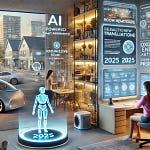Introduction: The Double-Edged Sword of AI
Artificial Intelligence (AI) has become an integral part of our daily lives, streamlining tasks, enhancing productivity, and opening new avenues for innovation. From virtual assistants managing our schedules to algorithms curating our news feeds, AI's influence is pervasive and growing exponentially. These technologies have transformed how we work, communicate, and access information, promising unprecedented efficiency and convenience.
However, beneath the surface of these conveniences lies a complex web of unintended consequences that warrant critical examination. As AI systems become more sophisticated and integrated into the fabric of society, we must pause to consider the full spectrum of their impact. The rapid advancement of AI technologies has outpaced our ability to fully understand and address their societal implications, creating a disconnect between technological progress and ethical considerations.
This article explores six key areas where AI's integration into everyday life may be producing hidden costs - impacts that often go unnoticed amid the excitement of technological advancement but nevertheless shape our cognitive abilities, social structures, and fundamental human experiences.
1. Cognitive Offloading: Convenience at the Cost of Critical Thinking
AI tools have revolutionized the way we process information, offering instant solutions to complex problems. With a few clicks, we can access answers to virtually any question, perform complex calculations, and make decisions based on AI-generated recommendations. A study by Michael Gerlich at SBS Swiss Business School found that increased use of AI tools is linked to reduced critical thinking skills, primarily due to cognitive offloading. This phenomenon occurs when we transfer cognitive processes to external devices, diminishing our internal capacity for these functions over time.
While AI can handle routine tasks efficiently, overdependence may erode our capacity for independent analysis and problem-solving. Educational institutions are particularly concerned about this trend, as students increasingly rely on AI tools for assignments that were once designed to develop analytical skills. The convenience of immediate answers may be creating a generation less equipped to engage in deep thinking, evaluate evidence, and form independent judgments.
Furthermore, this cognitive offloading extends beyond academic contexts into professional settings, where decision-makers may defer to algorithmic recommendations without understanding the underlying logic or considering alternative perspectives. The long-term implications of this shift may include diminished innovation, reduced resilience in problem-solving, and a workforce less capable of adapting to novel challenges that AI cannot yet address.
2. Data Centralization: The New Gatekeepers of Knowledge
The consolidation of data by a few tech giants has created centralized repositories of information, raising concerns about access and control. A report from Medium highlights the risks of centralized AI data centers, emphasizing the need for decentralization to promote fair competition and prevent monopolistic control over information. These tech behemoths now control unprecedented amounts of data, which serves as the foundation for AI development and implementation.
This centralization can stifle innovation and limit diverse perspectives, as smaller entities struggle to compete with established players who benefit from network effects and economies of scale. The barriers to entry in AI development have grown substantially, creating a landscape where only well-resourced organizations can participate meaningfully in shaping the technology's future.
Beyond economic concerns, data centralization raises profound questions about power dynamics in the information age. When a handful of corporations control the infrastructure through which knowledge is created, organized, and disseminated, they effectively become the arbiters of truth and visibility. This concentration of power extends to influence over political discourse, cultural narratives, and even academic research priorities, potentially undermining democratic principles and diverse knowledge systems.
Additionally, centralized data repositories present attractive targets for cyberattacks, raising security concerns that affect individuals, organizations, and national interests. The vulnerability of these systems contrasts sharply with more distributed approaches to data storage and processing, highlighting another hidden cost of our current trajectory.
3. The Disappearing Middle: AI's Impact on Employment
AI's integration into various industries has led to the automation of tasks traditionally performed by middle-skill workers. This shift threatens the stability of the middle class, as jobs are either eliminated or transformed beyond recognition. The National Bureau of Economic Research discusses how AI, if applied thoughtfully, can assist in restoring middle-class jobs, but warns of the potential for job displacement if not managed properly.
The employment landscape is experiencing a polarization effect, with growth concentrated in both high-skill, high-wage positions and low-skill, low-wage roles, while middle-skill occupations diminish. This hollowing out of the middle class has significant implications for social mobility, economic inequality, and political stability, as historically, a robust middle class has been associated with democratic governance and social cohesion.
The nature of work itself is changing as AI assumes routine cognitive tasks, shifting human labor toward roles requiring emotional intelligence, creativity, and adaptability. This transition creates winners and losers, with those able to complement AI capabilities thriving while others struggle to find their place in the transformed economy. The speed of this transition often outpaces the development of effective retraining programs or social safety nets, leaving displaced workers vulnerable to prolonged unemployment or underemployment.
Furthermore, AI's impact on employment extends beyond job numbers to questions of work quality, autonomy, and fulfillment. As algorithms increasingly manage, monitor, and evaluate human workers, many experience a loss of agency and increased stress, even in positions that remain technically secure from automation. This surveillance-based management approach represents another hidden cost of AI integration, affecting worker well-being and dignity.
4. Social Isolation: Personalized Algorithms and the Echo Chamber Effect
AI-driven personalization tailors content to individual preferences, enhancing user experience through recommendation systems that seem to anticipate our desires. However, this customization can lead to echo chambers, reinforcing existing beliefs and isolating users from diverse viewpoints. Psychology Today notes that AI recommendation algorithms can worsen loneliness by creating individualized echo chambers, leading to social isolation and a reinforcement of rigid mindsets.
The psychological impact of these algorithmically curated experiences is profound, as they create comfortable information bubbles that shield us from challenging ideas and contrary evidence. This artificial harmony may feel satisfying in the moment but ultimately contributes to social fragmentation and polarization. As individuals consume increasingly tailored content, common ground diminishes, making constructive dialogue across ideological divides more difficult.
Moreover, the design of these systems often prioritizes engagement over well-being, exploiting psychological vulnerabilities to maximize user attention. Content that evokes strong emotional responses—particularly outrage, fear, or tribal allegiance—tends to generate more interaction, creating a feedback loop that amplifies divisive content at the expense of nuanced discussion.
Social media platforms, powered by these algorithms, have transformed from spaces of connection to engines of division, with significant consequences for mental health, civic discourse, and democratic functioning. The personalization that was intended to enhance user experience has, in many cases, undermined the very social fabric these platforms initially aimed to strengthen.
5. The Illusion of Perfection: AI and Unrealistic Standards
AI-generated content often presents an idealized version of reality, setting unattainable standards across multiple domains. Vogue Business discusses how AI is influencing beauty standards, raising ethical concerns about the perpetuation of unrealistic and biased ideals. In the realm of beauty and social media, AI influencers and beauty pageants promote homogenized ideals, impacting self-perception and contributing to body image issues.
The technological perfection of AI-generated imagery, with its flawless symmetry and unnatural consistency, establishes benchmarks that human beings cannot achieve. This dynamic is particularly harmful in visual domains, where the line between enhanced and entirely fabricated imagery has blurred, leaving viewers uncertain about what represents authentic human appearance.
Beyond physical appearance, AI-generated content also sets unrealistic standards for productivity, creativity, and lifestyle. The ability of AI to produce polished work at unprecedented speeds creates pressure on human creators to match this output, leading to burnout and diminished satisfaction in creative pursuits. Similarly, lifestyle content generated or enhanced by AI presents curated perfection that bears little resemblance to the messy reality of human existence.
These artificially constructed ideals affect not only individual self-esteem but also shape cultural values and social expectations. As these technologies advance, distinguishing between authentic human creation and AI-generated content becomes increasingly challenging, raising fundamental questions about authenticity and value in a world where perfect simulation is increasingly accessible.
6. Emotional Labor: The Human Cost of AI Integration
As AI takes over routine tasks, human workers are increasingly required to perform emotional labor, managing customer interactions and compensating for AI's shortcomings. A study published in the Journal of Business Research highlights how AI adoption can lead to job stress and burnout, emphasizing the need for strategies to mitigate these effects. This shift toward emotional labor represents a significant, often overlooked cost of technological progress.
In customer service settings, for example, human agents now primarily handle complex, emotionally charged situations that AI cannot navigate effectively. These interactions are inherently more demanding than the routine inquiries now managed by chatbots and virtual assistants, leading to increased emotional exhaustion among workers. The expectation that humans will seamlessly integrate with AI systems, filling gaps in technological capabilities while maintaining empathy and patience, places extraordinary demands on workers across sectors.
Additionally, the emotional labor required to adapt to ever-changing technological systems creates a persistent state of uncertainty and stress. As AI capabilities evolve, human workers must continuously redefine their roles and develop new skills, often with minimal support or recognition for this adaptive labor. The psychological toll of this constant flux contributes to burnout and diminished job satisfaction.
The commodification of emotional labor also raises questions about authenticity in human interactions. As genuine emotional connection becomes a premium service provided by humans in an increasingly automated landscape, both workers and consumers may experience a sense of loss or alienation. This fundamental change in how we relate to one another represents yet another hidden cost of our AI-integrated future.
7. Algorithmic Bias: Perpetuating and Amplifying Inequalities
AI systems, trained on historical data that reflects existing societal biases, often reproduce and sometimes amplify these inequalities. Algorithmic bias manifests across various domains, from facial recognition technologies that perform poorly on darker skin tones to hiring algorithms that disadvantage women and minorities. These biases are not merely technical glitches but structural issues embedded in the development, deployment, and governance of AI systems.
The consequences of algorithmic bias extend far beyond individual experiences of discrimination, shaping access to opportunities, resources, and representation on a systemic level. When AI systems determine who receives loans, jobs, housing, or educational opportunities, biased outcomes can perpetuate historical patterns of marginalization while presenting these decisions as objective and data-driven.
The opacity of many AI systems compounds this problem, as those affected by biased algorithms often have no means to understand or challenge the decisions made about them. This lack of transparency creates a shield for discriminatory practices, allowing them to persist under the guise of technological neutrality. Despite growing awareness of these issues, meaningful solutions remain elusive, particularly when economic incentives favor rapid deployment over careful consideration of social impact.
8. Environmental Consequences: The Unseen Footprint of AI
The environmental costs of AI development and deployment represent a significant hidden expense. Training large AI models requires enormous computational resources, resulting in substantial energy consumption and carbon emissions. A single training run for an advanced language model can generate more carbon dioxide than dozens of cars produce in their lifetimes, raising questions about sustainability in an era of climate crisis.
Beyond energy consumption, AI systems require physical infrastructure, including data centers, cooling systems, and specialized hardware. The production of these components involves resource extraction, manufacturing emissions, and eventually creates electronic waste when hardware becomes obsolete. These material aspects of AI are often overlooked in discussions that focus primarily on algorithms and data.
The environmental impact extends to how AI shapes consumer behavior and resource management. While AI can optimize energy use in certain contexts, it also enables more efficient extraction of natural resources and facilitates consumption through personalized marketing and streamlined purchasing processes. These conflicting effects create a complex environmental calculus that deserves greater attention as we chart our technological future.
Conclusion: Navigating the AI-Driven Future
AI offers immense potential to enhance our lives, but it also presents challenges that must be addressed proactively. By acknowledging the hidden costs—cognitive decline, data centralization, job displacement, social isolation, unrealistic standards, increased emotional labor, algorithmic bias, and environmental impact—we can develop strategies to mitigate these effects while maximizing benefits.
Moving forward requires multi-stakeholder engagement, bringing together technologists, policymakers, educators, and civil society to shape AI development in alignment with human values and societal well-being. This collaborative approach must prioritize transparency, accountability, and inclusivity, ensuring that AI systems serve the diverse needs of humanity rather than narrower corporate or political interests.
Educational systems must evolve to emphasize the uniquely human capabilities that complement rather than compete with AI, fostering critical thinking, emotional intelligence, and ethical reasoning. Regulatory frameworks need to balance innovation with protection of fundamental rights and social goods, establishing guardrails that prevent the worst harms while allowing beneficial applications to flourish.
Embracing AI's benefits while remaining vigilant about its impact will ensure a future where technology serves humanity without compromising our values and well-being. This balanced approach recognizes that technology is neither inherently good nor bad, but rather a powerful tool whose effects depend on how we choose to design, deploy, and govern it.
Note: This article is based on current research and observations regarding AI's societal impact. Ongoing studies and discussions are essential to fully understand and address the complexities introduced by AI integration.
📚 References
Gerlich, M. (2024, January 25). AI use linked to eroding critical thinking skills, study finds. Phys.org
Lumerin Project. (2023, September 25). The hidden risks of centralized AI data centers and the case for decentralization. Medium
Acemoglu, D., & Restrepo, P. (2024, February). How AI can help (re)build the middle class. National Bureau of Economic Research
Lurie, A. (2024, April 9). AI recommendation algorithms can worsen loneliness. Psychology Today
Anderson, B. (2024, March 12). AI beauty pageants and hyper-perfectionism: Welcome to the age of Meta-face. Vogue Business
Hou, F., Xie, X., Xu, Y., & Wang, L. (2024, April 10). The double-edged sword of artificial intelligence in customer service: A psychological perspective on employee burnout. Humanities and Social Sciences Communications, 11(1). Nature
Thank you for your time today. Until next time, keep it real.
Do you like what you read but aren’t yet ready or able to get a paid subscription? Then consider a one-time tip at:
https://www.venmo.com/u/TheCogitatingCeviche
Ko-fi.com/thecogitatingceviche














Share this post